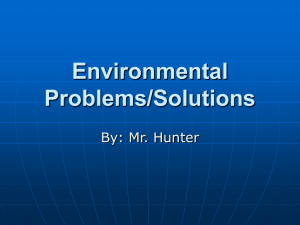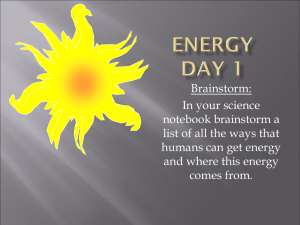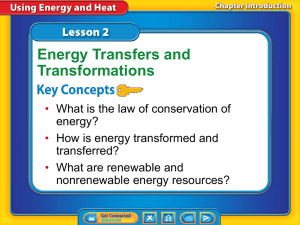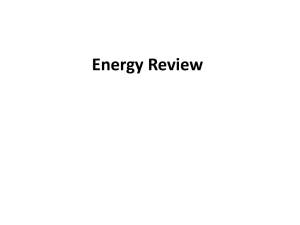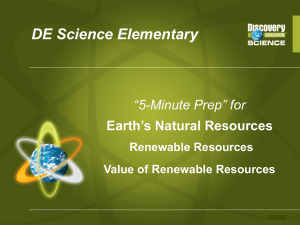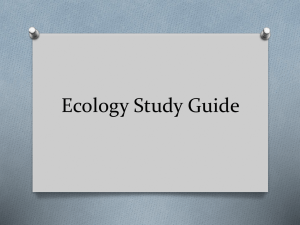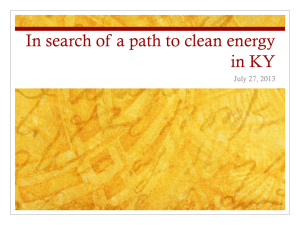EarthBootCamp_4.7C_AC
advertisement
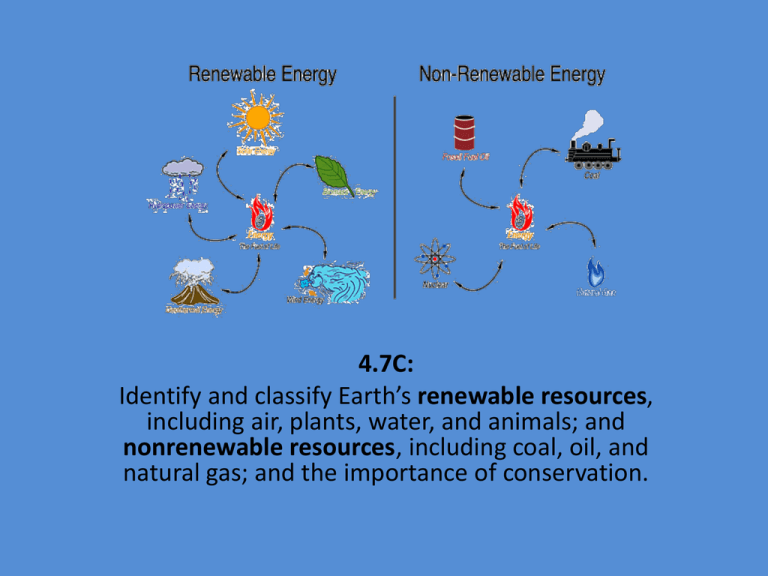
4.7C: Identify and classify Earth’s renewable resources, including air, plants, water, and animals; and nonrenewable resources, including coal, oil, and natural gas; and the importance of conservation. TAKS 2004—#28 (69%) 1. Which of these best completes this chart? F G H J Water Soil Coal Sand TAKS 2004—#28 (69%) 1. Which of these best completes this chart? F G H J Water Soil Coal Sand TAKS 2009—#21 (71%) 2. Which of the following is best classified as a nonrenewable resource? A Grass B Aluminum C Sunlight D Oxygen TAKS 2009—#21 (71%) 2. Which of the following is best classified as a nonrenewable resource? A Grass B Aluminum C Sunlight D Oxygen TAKS 2006—#12 (68%) 3. Which of these is a renewable resource? F G H J Diamonds Coal Oil Wind TAKS 2006—#12 (68%) 3. Which of these is a renewable resource? F G H J Diamonds Coal Oil Wind 4. Petroleum is considered a nonrenewable resource because— A B C D it cannot be replaced easily it can be replaced easily it is made into gasoline it is very thick and black 4. Petroleum is considered a nonrenewable resource because— A B C D it cannot be replaced easily it can be replaced easily it is made into gasoline it is very thick and black 5. Solar energy is— A B C D a renewable resource an inexhaustible resource a nonrenewable resource not very abundant on the Earth 5. Solar energy is— A B C D a renewable resource an inexhaustible resource a nonrenewable resource not very abundant on the Earth 6. Resources that can be replaced once they are used are called – A B C D nonrenewable resources renewable resources kilowatt resources unusable resources 6. Resources that can be replaced once they are used are called – A B C D nonrenewable resources renewable resources kilowatt resources unusable resources 7. Texas is a source of which of the following important nonrenewable resources? A B C D Oil and natural gas Solar and wind energy Forests and timber Diamonds and emeralds 7. Texas is a source of which of the following important nonrenewable resources? A B C D Oil and natural gas Solar and wind energy Forests and timber Diamonds and emeralds 8. Water is an important natural resource found all over the Earth. Where is most of the Earth’s fresh water located? A B C D In glaciers In lakes In oceans In houses 8. Water is an important natural resource found all over the Earth. Where is most of the Earth’s fresh water located? A B C D In glaciers In lakes In oceans In houses 9. Water that evaporates from lakes and rivers is constantly being replaced by precipitation. Therefore, the water in lakes and rivers is – A B C D a fossil resource a renewable resource a nonrenewable resource an exhaustible resource 9. Water that evaporates from lakes and rivers is constantly being replaced by precipitation. Therefore, the water in lakes and rivers is – A B C D a fossil resource a renewable resource a nonrenewable resource an exhaustible resource 10. A renewable resource can be replaced in a relatively short period of time. A nonrenewable resource takes thousands or millions of years to be replaced. Which of the following is a nonrenewable source of energy? A B C D Solar power Petroleum Wind Moving water 10. A renewable resource can be replaced in a relatively short period of time. A nonrenewable resource takes thousands or millions of years to be replaced. Which of the following is a nonrenewable source of energy? A B C D Solar power Petroleum Wind Moving water 11. Coal is formed when organic materials are buried undergrounds and subjected to great pressure. If coal replaces itself naturally, why is it considered a nonrenewable resource? A B C D Coal is very hard to find on the surface of the Earth. It is very difficult to mine coal from under the ground. It takes millions of years for new deposits of coal to form. Coal is burned in order to generate electricity. 11. Coal is formed when organic materials are buried undergrounds and subjected to great pressure. If coal replaces itself naturally, why is it considered a nonrenewable resource? A B C D Coal is very hard to find on the surface of the Earth. It is very difficult to mine coal from under the ground. It takes millions of years for new deposits of coal to form. Coal is burned in order to generate electricity. 12. Which of the following is a renewable resource? A B C D Wood, because trees grow again fairly quickly Coal, because more can be made in about 100 years Petroleum, because it can be made into gasoline Gold, because more can be taken out of the ground 12. Which of the following is a renewable resource? A B C D Wood, because trees grow again fairly quickly Coal, because more can be made in about 100 years Petroleum, because it can be made into gasoline Gold, because more can be taken out of the ground 13. What are the various things made by nature and used by people called? A B C D Energy Metals Resources Minerals 13. What are the various things made by nature and used by people called? A B C D Energy Metals Resources Minerals 14. Which of the following resource categories best describes fossil fuels? A B C D Recyclable Renewable Nonrenewable Inexhaustible 14. Which of the following resource categories best describes fossil fuels? A B C D Recyclable Renewable Nonrenewable Inexhaustible 15. Which of the following is a renewable resource? A B C D A chicken Petroleum Dr. Pepper® Diamonds 15. Which of the following is a renewable resource? A B C D A chicken Petroleum Dr. Pepper® Diamonds 16. Which statement about renewable resources is true? A B C D Coal and water are both renewable resources. Water is a renewable resource, but coal is not. Minerals and oil are both renewable resources. Oil is a renewable resource, but minerals are not. 16. Which statement about renewable resources is true? A B C D Coal and water are both renewable resources. Water is a renewable resource, but coal is not. Minerals and oil are both renewable resources. Oil is a renewable resource, but minerals are not. 17. All of the following are considered to be nonrenewable natural resources EXCEPT— A B C D animals petroleum natural gas minerals 17. All of the following are considered to be nonrenewable natural resources EXCEPT— A B C D animals petroleum natural gas minerals 18. The custodian just finished mowing the yard in front of the school. Which of the following resources in the school yard is NOT considered renewable? A B C D The gasoline used in the mower The soil in which the grass grows The grass and other plants in the yard The water from the sprinkler that keeps the grass alive 18. The custodian just finished mowing the yard in front of the school. Which of the following resources in the school yard is NOT considered renewable? A B C D The gasoline used in the mower The soil in which the grass grows The grass and other plants in the yard The water from the sprinkler that keeps the grass alive 19. Electricity to play your radio can be made using renewable or nonrenewable resources. Which of the following resources are renewable? A B C D wind and oil wind and sunlight natural gas and oil natural gas and coal 19. Electricity to play your radio can be made using renewable or nonrenewable resources. Which of the following resources are renewable? A B C D wind and oil wind and sunlight natural gas and oil natural gas and coal 20. A student is making a poster about conserving nonrenewable resources. Which of the following resources might she include on her poster? F G H J Wind Sunlight Plants Petroleum 20. A student is making a poster about conserving nonrenewable resources. Which of the following resources might she include on her poster? F G H J Wind Sunlight Plants Petroleum Start of MS ?’s 21. Students are classifying renewable and nonrenewable resources. They created a table to organize their data. Renewable Resources Nonrenewable Resources Plants Coal Animals Natural gas Water ?? Which resource below best completes the table?? F G H J air solar oil soil Start of MS ?’s 21. Students are classifying renewable and nonrenewable resources. They created a table to organize their data. Renewable Resources Nonrenewable Resources Plants Coal Animals Natural gas Water ?? Which resource below best completes the table?? F G H J air solar oil soil 22. Many of our daily routines rely on the use of nonrenewable resources. Because there is only a limited supply available, conserving these resources is very important. What is another important reason to conserve these limited supplies? A. To learn how to function when the supplies run out B. To create more nonrenewable resources C. To harm the environment and cause drastic changes D. To increase the cost of resources 22. Many of our daily routines rely on the use of nonrenewable resources. Because there is only a limited supply available, conserving these resources is very important. What is another important reason to conserve these limited supplies? A. To learn how to function when the supplies run out B. To create more nonrenewable resources C. To harm the environment and cause drastic changes D. To increase the cost of resources 23. All of the following are advantages for using renewable resources EXCEPT— A. they can be replenished in a short period of time B. they can be used repeatedly without decreasing the supply C. they reduce the demand of fossil fuels D. they have a positive impact on our environment and our lives 23. All of the following are advantages for using renewable resources EXCEPT— A. they can be replenished in a short period of time B. they can be used repeatedly without decreasing the supply (supply will decrease if we used them repeatedly – still need to conserve renewable resources) C. they reduce the demand of fossil fuels D. they have a positive impact on our environment and our lives 24. Why are coal, oil, and natural gas considered nonrenewable resources? A. There is a limited supply, and they can be replaced in a short period of time. B. There is not a limited supply, and they cannot be replenished in a short period of time. C. There is a limited supply, and they cannot be replenished in a short period of time. D. There is not a limited supply, and they can be replaced in a short period of time. 24. Why are coal, oil, and natural gas considered nonrenewable resources? A. There is a limited supply, and they can be replaced in a short period of time. B. There is not a limited supply, and they cannot be replenished in a short period of time. C. There is a limited supply, and they cannot be replenished in a short period of time. D. There is not a limited supply, and they can be replaced in a short period of time. 25. Scientists are looking for ways to produce energy from natural materials, such as plants, without depleting limited natural resources. Plants are considered a good alternative because they are— A. nonrenewable B. inexhaustible C. reusable D. renewable 25. Scientists are looking for ways to produce energy from natural materials, such as plants, without depleting limited natural resources. Plants are considered a good alternative because they are— A. nonrenewable B. inexhaustible C. reusable D. renewable 26. All the pictures below identify conserving renewable and nonrenewable resources EXCPT— You need to turn off the facet when you brush your teeth! 26. All the pictures below identify conserving renewable and nonrenewable resources EXCPT— 27. Fossil fuels were formed from organic matter buried more than a hundred thousand years ago. This matter changed over a long period of time into coal, oil, and natural gas. Fossil fuels formed from plants and animals are – A. renewable B. inexhaustible C. unusable D. nonrenewable 27. Fossil fuels were formed from organic matter buried more than a hundred thousand years ago. This matter changed over a long period of time into coal, oil, and natural gas. Fossil fuels formed from plants and animals are – A. renewable B. inexhaustible C. unusable D. nonrenewable 28. Which of the following is NOT identified as a renewable resource? A. fish population B. natural vegetation C. mineral deposits D. corn crop 28. Which of the following is NOT identified as a renewable resource? A. fish population B. natural vegetation C. mineral deposits D. corn crop 29. Which item is an example of a nonrenewable resource? A. animal B. cactus C. wind D. oil 29. Which item is an example of a nonrenewable resource? A. animal B. cactus C. wind D. oil 30. Which statement best describes a way to conserve energy? A. Leave the lights on when you leave a room. B. Run the faucet while you are brushing your teeth. C. Walk or ride a bike to school instead of riding in a car. D. Take long showers with hot water. 30. Which statement best describes a way to conserve energy? A. Leave the lights on when you leave a room. B. Run the faucet while you are brushing your teeth. C. Walk or ride a bike to school instead of riding in a car. D. Take long showers with hot water. 31. Fossil fuels are used to produce about 80% of the energy we use on Earth. Which statement best describes how fossil fuels affect the environment? A. Fossil fuels produce carbon dioxide and pollution. B. Fossil fuels are used faster than they can be replaced. C. Fossil fuels are used to make energy for engines. D. Fossil fuels produce oxygen which plants turn into carbon dioxide. 31. Fossil fuels are used to produce about 80% of the energy we use on Earth. Which statement best describes how fossil fuels affect the environment? A. Fossil fuels produce carbon dioxide and pollution. B. Fossil fuels are used faster than they can be replaced. C. Fossil fuels are used to make energy for engines. D. Fossil fuels produce oxygen which plants turn into carbon dioxide. 32. Which best explains why air is classified as a renewable resource? A. It is formed by the remains of plants and animals. B. It is recycled in the water cycle. C. It is formed over time by heat and pressure. D. It is recycled in the carbon dioxide-oxygen cycle. 32. Which best explains why air is classified as a renewable resource? A. It is formed by the remains of plants and animals. B. It is recycled in the water cycle. C. It is formed over time by heat and pressure. D. It is recycled in the carbon dioxide-oxygen cycle. 33. According to this chart, how much water can be saved by taking a bath in a full tub of water rather than taking a 10-minute shower? Water used Shower 26 liters/minute Bathtub 132 liters/fill Clothes washer 125 liters/load Dishwasher 57 liters/load Bathroom faucet 19 liters/minute 33. According to this chart, how much water can be saved by taking a bath in a full tub of water rather than taking a 10-minute shower? Water used Shower 26 liters/minute Bathtub 132 liters/fill Clothes washer 125 liters/load Dishwasher 57 liters/load Bathroom faucet 19 liters/minute 10 minute shower:26 x 10= 260 liters Full bathtub: 132 liters 260-132= 128 liters wasted – WOW!! 34. According to this chart, how much water would you use if you brushed your teeth for 2 minutes and didn’t turn off the faucet? Water used Shower 26 liters/minute Bathtub 132 liters/fill Clothes washer 125 liters/load Dishwasher 57 liters/load Bathroom faucet 19 liters/minute 34. According to this chart, how much water would you use if you brushed your teeth for 2 minutes and didn’t turn off the faucet? Water used Shower 26 liters/minute Bathtub 132 liters/fill Clothes washer 125 liters/load Dishwasher 57 liters/load Bathroom faucet 19 liters/minute 19x2=38 liters of water – WOW!! 35. Why is it important to wait until the dishwasher is completely full until you run it? Water used Shower 26 liters/minute Bathtub 132 liters/fill Clothes washer 125 liters/load Dishwasher 57 liters/load Bathroom faucet 19 liters/minute 35. Why is it important to wait until the dishwasher is completely full until you run it? Water used Shower 26 liters/minute Bathtub 132 liters/fill Clothes washer 125 liters/load Dishwasher 57 liters/load Bathroom faucet 19 liters/minute So you can conserve water! 36. Scientists are working very hard to develop new ways to use clean energy sources which come from renewable resources. Which of the following is an example of a renewable resource? A. natural gas B. petroleum C. water D. coal 36. Scientists are working very hard to develop new ways to use clean energy sources which come from renewable resources. Which of the following is an example of a renewable resource? A. natural gas B. petroleum C. water D. coal 37. All of the following are wise choices of conserving nonrenewable resources EXCEPT— A. cutting back what is used B. reusing materials C. reprocessing used materials D. using as many materials as possible 37. All of the following are wise choices of conserving nonrenewable resources EXCEPT— A. cutting back what is used B. reusing materials C. reprocessing used materials D. using as many materials as possible Natural Resources Renewable Cow Oxygen Nonrenewable Fruit ?? Petroleum Coal Natural gas 38. Which best completes the chart? A. Oil B. Timber C. Fossils Fossil Fuels Minerals Natural Resources Renewable Cow Oxygen Nonrenewable Fruit ?? Petroleum Coal Natural gas 38. Which best completes the chart? A. Oil B. Timber C. Fossils Fossil Fuels Minerals 39. A group of students plan to conduct an activity to determine which natural resources are renewable and nonrenewable. Before starting the activity, the students wrote down which materials they thought would be renewable, and which they guessed would be nonrenewable. What information did the students record before the activity began? A. an observation B. a hypothesis C. an inference D. a conclusion 39. A group of students plan to conduct an activity to determine which natural resources are renewable and nonrenewable. Before starting the activity, the students wrote down which materials they thought would be renewable, and which they guessed would be nonrenewable. What information did the students record before the activity began? A. an observation B. a hypothesis C. an inference D. a conclusion 40. Conserving any resource always makes sense. Which of the following is NOT a good reason to conserve renewable and nonrenewable resources? A. to produce pollutants B. to reduce waste C. to care for future generations D. to preserve the environment 40. Conserving any resource always makes sense. Which of the following is NOT a good reason to conserve renewable and nonrenewable resources? A. to produce pollutants B. to reduce waste C. to care for future generations D. to preserve the environment 41. The table shows the approximate number of animals remaining for certain species on the endangered species list. Animal # remaining Tiger 3200 Mountain gorilla 786 Giant panda 2500 Black rhinoceros 3725 Hawksbill turtle 8000 Blue whale 4000 Bactrian camel 1000 Based on the information in the table, which animal has the greatest chance of becoming extinct? 41. The table shows the approximate number of animals remaining for certain species on the endangered species list. Animal # remaining Tiger 3200 Mountain gorilla 786 Giant panda 2500 Black rhinoceros 3725 Hawksbill turtle 8000 Blue whale 4000 Bactrian camel 986 Based on the information in the table, which animal has the greatest chance of becoming extinct?
